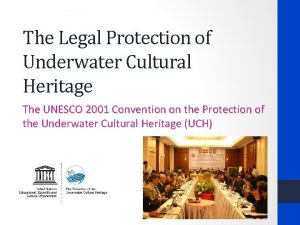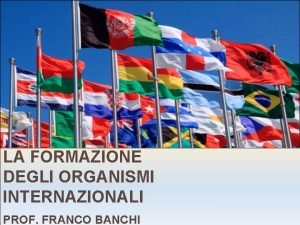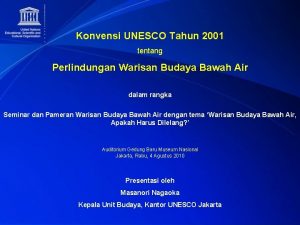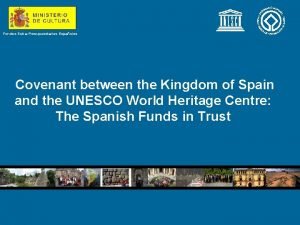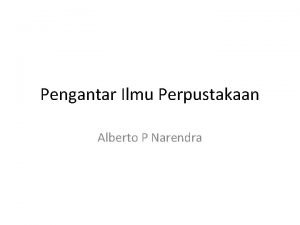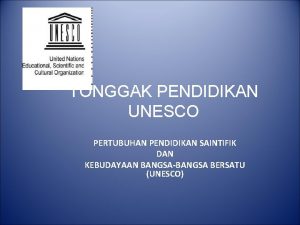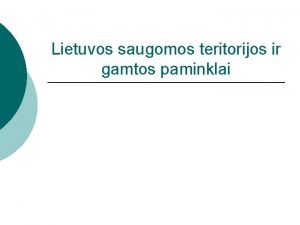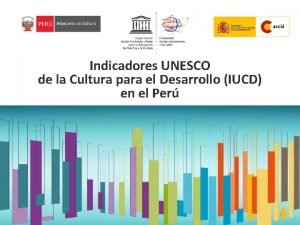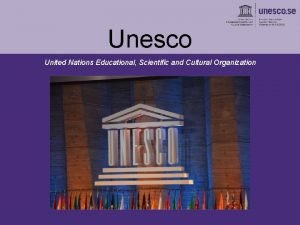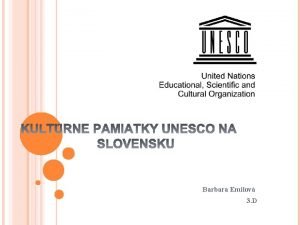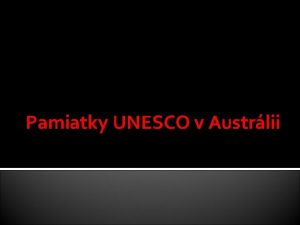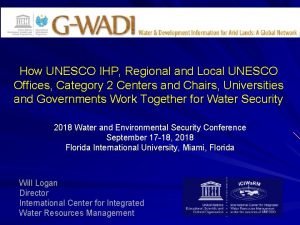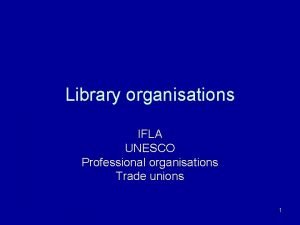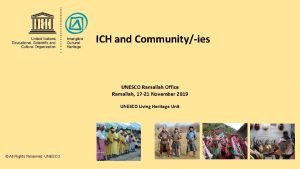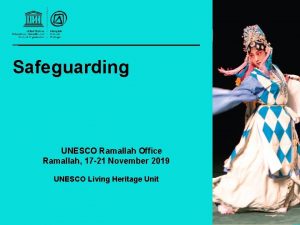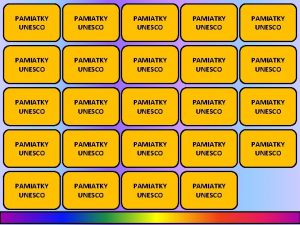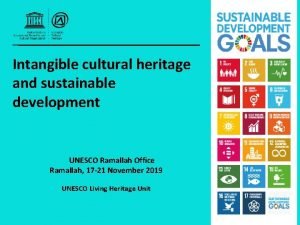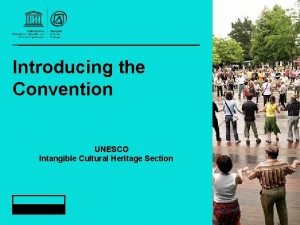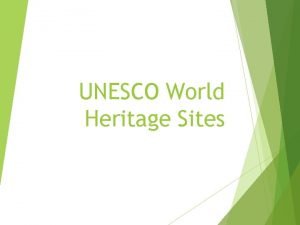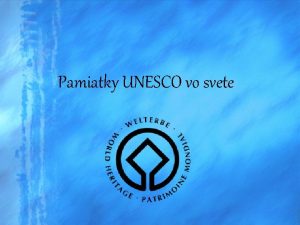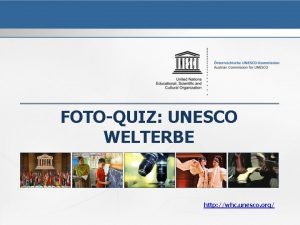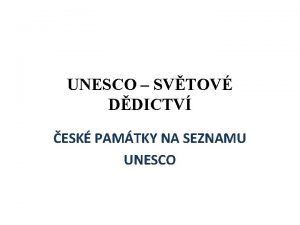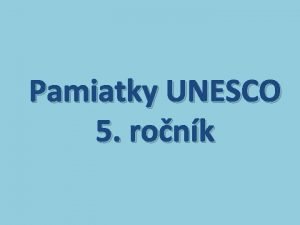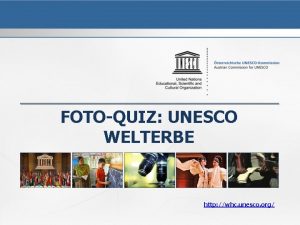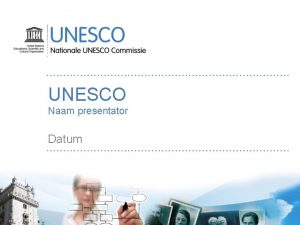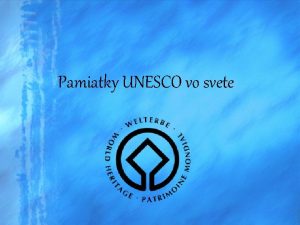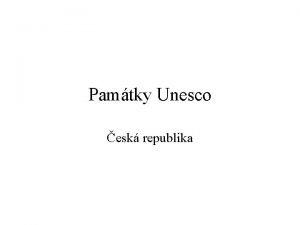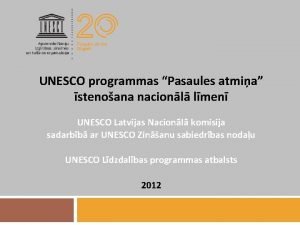Introducing the Convention UNESCO Ramallah Office Ramallah 17























- Slides: 23

Introducing the Convention UNESCO Ramallah Office Ramallah, 17 -21 November 2019 UNESCO Living Heritage Unit

In this presentation … UNESCO and its Conventions The Intangible Heritage Convention • Purposes of the Convention • Organs of the Convention • Two Lists and a Register • Operational Directives (ODs) • Obligations and benefits The Woodcrafting Knowledge of the Zafimaniry © J. Ségur/ZED Inscribed on the RL in 2008 2

UNESCO and its Conventions Intergovernmental organization with 195 Member States Five sectors: Education, Natural Sciences, Social & Human Sciences, Culture and Communication & Information Seven UNESCO Conventions in the fields of culture and heritage: • tangible, intangible and natural heritage • diversity of cultural expressions • copyright 3

Three related UNESCO Conventions on culture and heritage There are three related UNESCO conventions on culture and heritage: • Convention concerning the Protection of the World Cultural and Natural Heritage (1972) • Convention for the Safeguarding of the Intangible Cultural Heritage (2003) • Convention on the Protection and Promotion of the Diversity of Cultural Expressions (2005) 4

A popular Convention • 178 countries’ ratifications 2006 -2018 • 508 inscribed elements from 122 countries • 39 multinational inscriptions corresponding to 73 countries • 38 files considered exemplary from 30 countries © All Rights Reserved: UNESCO 5

Contents of the Intangible Heritage Convention Preamble Lists and Register (Articles 16– 18) Purposes of the Convention International cooperation and (Article 1) Definitions (Article 2) ICH Fund (Articles 25– 28) Organs of the Convention (Articles 4– 10) Reporting (Articles 29– 30) Safeguarding – national level (Articles 11– 15) 6 assistance (Articles 19 -24) Ratification, etc. (Articles 32– 33)

© A l l R i g h t s R e s e r v e d : U N E S C O The Convention’s definition of intangible heritage (1) Article 2. 1: For the purposes of the Convention, the ‘Intangible Cultural Heritage’ means the practices, representations, expressions, knowledge, skills – as well as the instruments, objects, artefacts and cultural spaces associated therewith – that communities, groups and, in some cases, individuals recognize as part of their cultural heritage. 7

© A l l R i g h t s R e s e r v e d : U N E S C O The Convention’s definition of intangible heritage (2) Article 2. 1 continues: This intangible cultural heritage, transmitted from generation to generation, is constantly recreated by communities and groups in response to their environment, their interaction with nature and their history, and provides them with a sense of identity and continuity, thus promoting respect for cultural diversity and human creativity. 8

© A l l R i g h t s R e s e r v e d : U N E S C O The Convention’s definition of intangible heritage (3) Article 2. 1 further: For the purposes of this Convention, consideration will be given solely to such intangible cultural heritage as is compatible with existing international human rights instruments, as well as with the requirements of mutual respect among communities, groups and individuals, and of sustainable development. 9

© A l l R i g h t s R e s e r v e d : U N E S C O Intangible heritage domains Article 2. 2 (a) oral traditions and expressions, including language as a vehicle of the intangible cultural heritage; (b) performing arts; (c) social practices, rituals and festive events; (d) knowledge and practices concerning nature and the universe; (e) traditional craftsmanship. 10

Objectives of the Convention Article 1 Safeguarding Respect Awareness and mutual appreciation International cooperation and assistance 11

The two Lists of the Convention • Representative List of the Intangible Cultural Heritage of Humanity – RL (Article 16) • List of Intangible Cultural Heritage in Need of Urgent Safeguarding – USL (Article 17) 12

Sanké mon: collective fishing rite of the Sanké The Sanké mon collective fishing rite takes place annually in the Ségou region of Mali to mark the beginning of the rainy season and commemorate the founding of the town of San. In recent years, fewer people have attended the rite because of diminishing awareness of its function and history, occasional accidents and the degradation of the Sanké lake. Inscribed on the USL in 2009. © Direction Nationale du Patrimoine Culturel, Ministère de la Culture du Mali, 2009 13

The Tango is a symbol of the popular culture of Argentina and Uruguay, especially their capital cities. Originating in the working-class neighbourhoods of Buenos Aires and Montevideo, the Tango dates back to the late nineteenth century. Practised spontaneously and in more formal settings, it enjoys great popularity, both locally and worldwide. Inscribed on the RL in 2009. © Ministerio de Cultura de Argentina, Ciudad de Buenos Aires, 2008 14

Register of Good Safeguarding Practices Article 18 School Museum of Pusol (Spain) Guided by teachers, children explore the rich heritage of Elche by working with tradition bearers and documenting their heritage. © Centre for Traditional Culture, School Museum of Pusol, 2010 15

Organs of the Convention General Assembly: sovereign body of the Convention. All States Parties are members. Intergovernmental Committee: twenty-four Member States; implements the Convention. UNESCO Secretariat: serves the Organs; assists in implementing the Convention. 16

Operational Directives • Guide implementation of the Convention • Include regulations and procedures for Lists, Register and Fund as well as reporting obligations • Prepared by Committee, approved by General Assembly • First set approved 2008; amended and enlarged in 2012, 2014, 2016, 2018 17

Obligations of States Parties to the Convention • Safeguard ICH on their territory (Article 11(a)) • Ensure community participation in identifying, defining and managing their ICH (Articles 11(b) and 15) • Draw up inventories of the ICH in their territory (Article 12. 1) • Contribute to the ICH Fund (Article 26) • Report to the Committee (Article 29) 18

Benefits of implementing the Convention (1) Better safeguarding of the ICH within the States Parties, contributing to: • Well-being of communities • Respect and understanding between communities • Sustainable development • Enhancement of cultural diversity and human • creativity 19

Benefits of implementing the Convention (2) International cooperation and assistance: 20 • Sharing expertise and information internationally • Sharing safeguarding practices • Accessing assistance from the Fund • Nominating elements and safeguarding projects • Participating in the Organs of the Convention • Cooperating regionally and internationally: for example, on shared heritage

In conclusion (1) The Convention aims at: • Safeguarding ICH within and by communities in a context of sustainable development and mutual respect • Fully involving communities in any action concerning their ICH and empowering communities • Enhancing cultural diversity, human creativity, mutual understanding and international cooperation 21

In conclusion (2) The Convention: • Is run by an Intergovernmental Committee, controlled by a General Assembly, both assisted by the UNESCO Secretariat • Has Operational Directives, a Fund, two Lists and a Register of Good Practices • Ratification imposes some obligations on States Parties • Implementation brings benefits for States Parties, the communities concerned and other stakeholders 22

23
 Unesco ramallah
Unesco ramallah Unesco institute for statistics
Unesco institute for statistics Unesco dg
Unesco dg Conclusion of unesco
Conclusion of unesco L'onu mappa concettuale
L'onu mappa concettuale Konvensi unesco 2001
Konvensi unesco 2001 Austrliaa
Austrliaa Offerta conferenze internazionale geoparchi mondiali unesco
Offerta conferenze internazionale geoparchi mondiali unesco Nuria sanz unesco
Nuria sanz unesco Pengertian buku menurut unesco
Pengertian buku menurut unesco Aleksandra popovic unesco
Aleksandra popovic unesco Pertubuhan pendidikan saintifik dan kebudayaan
Pertubuhan pendidikan saintifik dan kebudayaan Gross enrolment ratio definition
Gross enrolment ratio definition Unesco child and family research centre
Unesco child and family research centre Unesco saugomos teritorijos lietuvoje
Unesco saugomos teritorijos lietuvoje Indicadores unesco de cultura para el desarrollo
Indicadores unesco de cultura para el desarrollo Unesco inclusive education
Unesco inclusive education Vad gör unesco
Vad gör unesco Francúzsko pamiatky unesco
Francúzsko pamiatky unesco Unesco
Unesco Ayersova skala
Ayersova skala Field offices unesco
Field offices unesco Ifla unesco
Ifla unesco Unesco conclusion
Unesco conclusion


